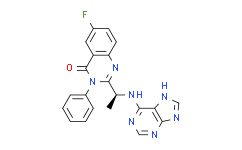| Cas No.: | 870281-34-8 |
| Chemical Name: | 6-fluoro-3-phenyl-2-[(1S)-1-(7H-purin-6-ylamino)ethyl]quinazolin-4-one |
| Synonyms: | 6-fluoro-3-phenyl-2-[(1S)-1-(7H-purin-6-ylamino)ethyl]quinazolin-4-one;Acalisib |
| SMILES: | O=C1N(C2=CC=CC=C2)C([C@@H](NC3=C4N=CNC4=NC=N3)C)=NC5=C1C=C(F)C=C5 |
| Formula: | C21H16N7OF |
| M.Wt: | 401.396 |
| Sotrage: | 2 years -20°C Powder, 2 weeks 4°C in DMSO, 6 months -80°C in DMSO |
| Description: | Acalisib is a potent and selective PI3Kδ inhibitor with an IC50 of 12.7 nM. |
| In Vivo: | To dissect the relative contribution of PI3Kα and PI3Kδ inhibition in the reduction of obesity, obese hyperphagic ob/ob mice are treated with a selective PI3Kα inhibitor, BYL-719, or with a selective PI3Kδ inhibitor, Acalisib (GS-9820). Remarkably, BYL-719 reduces body weight after 15 days of treatment to a similar extent as CNIO-PI3Ki, whereas Acalisib has no significant effect at the same doses as BYL-719. It should be noted that 10 mg/kg of Acalisib is sufficient to reduce the growth of multiple myeloma xenografts in mice[2]. |
| In Vitro: | Acalisib (GS-9820) is more selective for PI3Kδ (IC50=12.7 nM) relative to other PI3K class I enzymes (IC50: PI3Kα, 5,441 nM; PI3Kβ, 3,377 nM; PI3Kγ, 1,389 nM). Acalisib is also 103-fold more selective against PI3Kδ than against related kinases, such as PI3KCIIβ (IC50>10 nM), hVPS34 (IC50=12.7 μM), DNA-PK (IC50=18.7 μM), and mTOR (IC50>10 nM). In fibroblasts, the PDGF receptor signals through PI3Kα and the GPCR for lysophosphatidic acid (LPA) signals through PI3Kβ. Acalisib reduces PDGF-induced pAkt by only 50% at 11,585 nM, and LPA-induced pAkt by 50% at 2,069 nM. |

 To enhance service speed and avoid tariff delays, we've opened a US warehouse. All US orders ship directly from our US facility.
To enhance service speed and avoid tariff delays, we've opened a US warehouse. All US orders ship directly from our US facility.




















